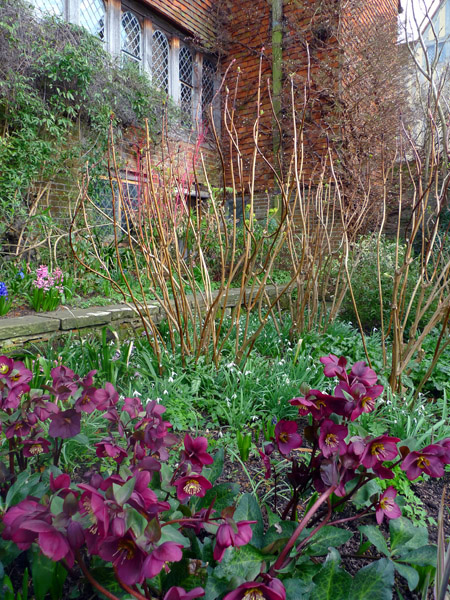
When I was fairly new to this gardening lark, I went to a Gardens Illustrated talk about Great Dixter during Chelsea week. Christopher Lloyd and Fergus Garrett showed slides on the history of Dixter and described how their planting evolved during the year. Christo must have been in his early eighties then and was as mischievous as ever – he clearly relished revealing the politically incorrect names of the pet daschsunds in old family photos, prompting a collective gasp from the audience.
At the end of the talk, a lady enquired as to whether Christo left his canna lily bulbs in the ground during winter.* ‘Leave them in the ground?’ he spluttered. ‘LEAVE THEM IN THE GROUND?! That’s a lazy man’s game!’**. He said that of course the bulbs were lifted every autumn, and that the lady should be under no illusions – Great Dixter was NOT a low-maintenance garden. Plants were continuously refreshed to give a good display – oriental poppies that were past their best might be replaced with the aforementioned cannas, for example, but the following year, he might do something different.
Dixter is known for its successional planting (planting that looks good throughout the seasons), something that many gardeners struggle with. Fergus hosts popular study days on this very subject and also gives short talks. As he flashes up inspirational photo after inspirational photo, you can’t scribble down his words of wisdom fast enough.
Some of the techniques Fergus describes are unashamedly high maintenance – replacing spent plants with an ever-changing array of annuals and bedding, for example. They also demand space (Dixter has a stock bed from which to pilfer plants). It takes real skill and plant knowledge to play with colour and to contrast textures and shapes, and Dixter’s constantly dazzling combinations may be beyond many of us.
However some of Dixter’s ideas are refreshingly simple. Fergus advises growing some plants that flower for months (such as Geranium riverslealanum ‘Russell Pritchard’) as opposed to more flash-in-the-pan varieties, and choosing plants that offer more than one season of interest in terms of foliage, stem colour or flowers. Dixter also makes use of unfashionable ‘car park’ shrubs such as Euonymus fortunei ‘Silver Queen’ and Cotoneaster horizontalis (which are reliable and actually quite nice) and scrambles climbers such as clematis over shrubs to extend interest. Plants are often allowed to self-seed in the borders, creating unexpected combinations (although this does take some managing – deputy head gardener Siew Lee says they edit out 90% of the seedlings).
One idea that I reckon everyone can get behind is to plant bulbs at the base of a shrub. They’re unlikely to be disturbed by digging, and they’ll bring colour to the garden before the shrub gets interesting. The bulbs will then retreat underground, letting the perennials planted around them take over. In the picture above, snowdrops are planted under hydrangeas; elsewhere, hyacinths pop up from under a spiraea and Tulipa sprengeri nestle under a fuchsia. This is definitely something an ordinary gardener could do – and should do, to get the most out of their small space.
*The lady’s question shows how things have changed – I shouldn’t think many people would contemplate leaving cannas outside these days, given our recent freezing winters.
**’That’s a lazy man’s game!’ is now one of my favourite sayings. One of my friends once heard it as ‘That’s a lesbian’s game!’ which gives it a whole new dimension.
PS: In case you’re wondering about the hellebores, they’re ‘Anna’s Red’, named after the garden writer Anna Pavord.




I always have a chuckle to myself when the word editing is mentioned. If it’s a wanted plant, the word is editing, if it’s an unwanted plant, then it’s weeding 😉
And I’d be very happy to have that gorgeous looking stock bed as my garden, never mind to pilfer from!
Ha! Good point. ‘I’m just off to edit the garden’ sounds much more exciting than weeding!
Perfect summing up of the glorious planting at Great Dixter. Sadly never got to hear or meet Christopher Lloyd, but do love reading his books. I shall be listening out to hear if “That’s a lazy man’s game” peppers your conversations in future. N x
Tee hee! I’ll try and get it in when I next see you! x
An enjoyable and very honest review of Great Dixter. It is a garden that is very inspiring as you say but also as you say one that is a lot more high maintenance than many people assume. I certainly wouldn’t want to garden in such a way that meant so much in-filling with annuals and stock plants. Actually it doesn’t always work so well; I’ve seen new plants added that were too small and looked completely wrong. Still I envy your visit, it sounds like it was a really great day out. Christina
Thanks Christina! Interesting comment. Fergus Garrett did say that they do get things wrong and that not everything goes to plan all of the time! I guess that’s inevitable in a garden that’s continually experimenting…
I really like the idea of the snowdrops under the hydrangeas; having just transplanted some galanthus in the green you have inspired me to do more! Thanks.
This time next year it will be you instead of Fergus Garrett!